
Materiali in Tehnologije
Scope & Guideline
Empowering Researchers in Metals and Polymers
Introduction
Aims and Scopes
- Materials Characterization and Performance:
The journal publishes studies on the mechanical, thermal, and tribological properties of various materials, including metals, polymers, and composites, focusing on how these properties are influenced by processing methods and material compositions. - Sustainable and Green Materials:
A core area of research is the development of sustainable materials and eco-friendly processes, including the use of waste materials, recycling, and environmentally responsible manufacturing techniques. - Advanced Manufacturing Techniques:
Research on state-of-the-art manufacturing processes such as additive manufacturing, laser processing, and welding technologies is a consistent focus, highlighting advancements in production efficiency and material properties. - Computational and Experimental Modeling:
The journal emphasizes both computational modeling and experimental investigations to understand material behavior under various conditions, providing insights into microstructural evolution and performance predictions. - Corrosion and Surface Engineering:
Studies aimed at understanding corrosion mechanisms and developing protective coatings and treatments to enhance material longevity are frequently published.
Trending and Emerging
- Nanocomposites and Hybrid Materials:
There is a growing interest in the development and application of nanocomposites and hybrid materials, leveraging advanced materials such as carbon nanotubes and metal oxides to enhance mechanical and thermal properties. - Smart Materials and Biomaterials:
Research on smart materials, including those with adaptive properties and biomaterials for medical applications, is on the rise, indicating a trend towards integrating materials science with healthcare and technology. - Energy-Efficient and Renewable Materials:
The journal shows an increasing emphasis on materials that contribute to energy efficiency and renewable energy applications, reflecting global sustainability goals. - Additive Manufacturing Innovations:
Innovations in additive manufacturing technologies are frequently highlighted, with studies focusing on new materials and processes that enhance the capabilities of 3D printing. - Advanced Coatings and Surface Modifications:
Research on advanced coatings and surface modifications aimed at improving corrosion resistance, wear resistance, and functional properties of materials is gaining prominence.
Declining or Waning
- Traditional Materials Testing Methods:
There has been a noticeable decrease in publications focusing solely on conventional materials testing methods, as researchers increasingly employ advanced techniques and computational models. - Historical Material Studies:
Research centered on the historical analysis of materials, such as studies on ancient construction techniques and materials, has seen reduced attention, possibly due to a shift towards contemporary applications and innovations. - Basic Materials Science:
Basic studies in materials science without direct applications or technological implications are becoming less common, as the focus shifts towards applied research that directly addresses current industrial challenges.
Similar Journals
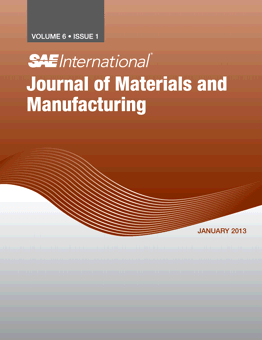
SAE International Journal of Materials and Manufacturing
Pioneering Discoveries in Materials and Manufacturing TechniquesSAE International Journal of Materials and Manufacturing, published by SAE International, is a leading peer-reviewed journal that focuses on the advancements and research in the fields of materials science and manufacturing engineering. With ISSN 1946-3979 and E-ISSN 1946-3987, this journal is an essential resource for researchers, professionals, and students who are keen on exploring innovative materials and modern manufacturing techniques. Although the journal currently does not offer open access options, its rigorous selection process ensures the publication of high-quality papers that contribute significantly to the knowledge base in the industry. Recognized within the third and fourth quartiles across various engineering categories, including Industrial and Manufacturing Engineering and Mechanical Engineering, the journal provides an impactful platform for disseminating groundbreaking research. With a converged history since 2002 and a comprehensive approach to critical topics in mechanics of materials, it empowers the academic community with vital insights, trends, and methodologies that propel the future of manufacturing excellence.
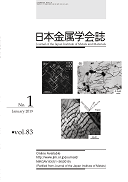
Journal of the Japan Institute of Metals and Materials
Connecting researchers and practitioners in metallurgy.Journal of the Japan Institute of Metals and Materials (ISSN: 0021-4876, E-ISSN: 1880-6880) serves as a vital academic platform under the esteemed auspices of the Japan Institute of Metals & Materials. This journal, with a rich publication history dating back to 1937, focuses on advancing knowledge in the fields of metallurgy, materials science, and engineering, making it an important resource for researchers, professionals, and students alike. Although the journal has been categorized in Q4 quartiles across several subject areas, including Condensed Matter Physics and Materials Chemistry, it plays a critical role in disseminating essential findings and fostering discussion regarding innovations in metal and materials research. Notably, the journal operates without open access, which encourages targeted readership engagement through its curated content. Based in Japan, it continues to contribute significantly to the academic community by bridging the gap between scientific inquiry and practical application in materials technology.
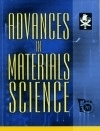
Advances in Materials Science
Fostering Collaboration for Material AdvancementsAdvances in Materials Science, published by SCIENDO, is a pivotal journal in the field of materials science that focuses on the latest developments and breakthroughs in the study and application of innovative materials. With a commitment to advancing knowledge across various sub-disciplines, this journal provides a platform for researchers, professionals, and students to share their findings, explore new methodologies, and discuss the implications of materials science on technology and industry. The journal, indexed under the ISSN 2083-4799 and E-ISSN 2083-4799, promotes open dissemination of research, encouraging a collaborative approach to problem-solving across disciplines. Its emphasis on high-quality, peer-reviewed articles positions it as an influential resource within the academic community, driving forward the boundaries of what is possible in materials science. Advances in Materials Science continues to be an essential read for anyone dedicated to understanding and innovating in the materials domain.
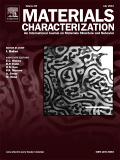
MATERIALS CHARACTERIZATION
Unveiling the Secrets of Material PropertiesMATERIALS CHARACTERIZATION is a leading international journal dedicated to the advancement of knowledge in the field of materials science and engineering. Published by Elsevier Science Inc, this esteemed journal has been disseminating vital research since 1970 and continues to be essential for scholars and industry professionals alike. With an impressive impact reflected in its Q1 quartile rankings across several categories—including Condensed Matter Physics, Materials Science, Mechanical Engineering, and Mechanics of Materials—MATERIALS CHARACTERIZATION stands out as a premier outlet for innovative studies and technical advancements. Researchers can access a wealth of peer-reviewed articles that explore properties, characterization techniques, and applications of materials, fostering interdisciplinary collaboration. With a commitment to high-quality research and comprehensive review processes, the journal plays a crucial role in shaping the future of materials science, making it an invaluable resource for anyone invested in this dynamic field.

Journal of Metals Materials and Minerals
Fostering Insights in the World of Materials and MineralsJournal of Metals Materials and Minerals (ISSN: 0857-6149) is a renowned academic publication dedicated to the interdisciplinary fields of metallurgical science, materials engineering, and mineralogy. Published by Chulalongkorn University, Metallurgy & Materials Science Research Institute in Thailand, this journal serves as a pivotal platform for researchers to disseminate their findings and explore innovative applications related to metals, ceramics, polymers, and biomaterials. Although the journal does not currently adopt an open-access model, it provides insightful content that facilitates knowledge sharing among professionals and academics alike. The journal has established its credibility with impressive Scopus ranking percentiles, particularly in categories such as Metals and Alloys and Ceramics and Composites. With an emphasis on advancing the understanding of materials science from 2017 to 2024, the Journal of Metals Materials and Minerals remains an essential resource for those striving to contribute to and stay informed about the latest trends and breakthroughs in these dynamic fields.

RARE METAL MATERIALS AND ENGINEERING
Connecting Knowledge in Materials Chemistry and EngineeringRARE METAL MATERIALS AND ENGINEERING is a vital academic journal dedicated to advancing the fields of materials science, engineering, and metallurgy. Published by the NORTHWEST INST NONFERROUS METAL RESEARCH in China, this journal has been an essential resource for researchers and professionals since its inception in 1993. With a focus on rare metals and their engineering applications, the journal addresses contemporary issues and innovations in materials chemistry and electronic engineering, providing insights into the properties and uses of advanced materials. Although it currently falls within the Q4 category for several categories, including Electrical and Electronic Engineering and Materials Chemistry, its commitment to quality and relevance in the field is evident. The journal offers a platform for researchers to share their findings with the scientific community, fostering collaboration and knowledge exchange in an important area of study. Researchers and students interested in exploring the latest in rare metal technologies and engineering methodologies will find this journal a valuable addition to their academic library.

International Journal of Manufacturing Materials and Mechanical Engineering
Unveiling cutting-edge insights in manufacturing and mechanics.International Journal of Manufacturing Materials and Mechanical Engineering, published by IGI GLOBAL, is a pivotal platform dedicated to the advancements in the fields of mechanical engineering and materials science. With an ISSN of 2156-1680 and an E-ISSN of 2156-1672, this journal has been addressing key contemporary issues since its inception in 2011, aiming to foster high-quality scholarly communication through impactful research until 2024. Despite its ranking in the Q4 category for both Mechanical Engineering and Mechanics of Materials in 2023 and its Scopus rankings placing it at the 49th and 44th percentiles respectively, the journal serves as an essential resource for researchers and professionals seeking to stay ahead in their fields. By incorporating rigorous peer-reviewed articles and innovative study findings, the journal not only enhances knowledge but also influences future research and practices in manufacturing and mechanical engineering. Researchers, practitioners, and students alike will find this journal invaluable for keeping abreast of emerging trends and technological advancements.
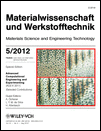
MATERIALWISSENSCHAFT UND WERKSTOFFTECHNIK
Unraveling the Mysteries of Material Properties.MATERIALWISSENSCHAFT UND WERKSTOFFTECHNIK, published by WILEY-V C H VERLAG GMBH, is a prominent journal dedicated to the field of materials science and engineering. With its ISSN 0933-5137 and E-ISSN 1521-4052, this journal serves as a vital resource for researchers and professionals engaged in exploring the intricate relationships between the properties of materials and their applications. Established in 1970 and continuing through 2024, the journal has been consistently recognized in various categories, achieving a Q3 ranking in 2023 across Condensed Matter Physics, Materials Science (miscellaneous), Mechanical Engineering, and Mechanics of Materials. Although it does not offer open access, its high-quality peer-reviewed content is fundamental to the advancement of knowledge within its three key areas: novel material development, material characterization, and application of materials in engineering contexts. As a driving force in the scientific community, MATERIALWISSENSCHAFT UND WERKSTOFFTECHNIK continues to cater to the curiosity of aspiring students, seasoned professionals, and researchers alike, facilitating a deeper understanding of the complexities of material technology.

JOURNAL OF MATERIALS ENGINEERING AND PERFORMANCE
Shaping the Future of Engineering with Innovative InsightsJOURNAL OF MATERIALS ENGINEERING AND PERFORMANCE, published by Springer, serves as a vital resource for researchers and professionals in the fields of materials science, mechanical engineering, and mechanics of materials. With an ISSN of 1059-9495 and E-ISSN of 1544-1024, this journal boasts a commendable track record since its inception in 1992 and is set to continue providing valuable insights until 2024. Positioned in the Q2 quartile of its categories, the journal is ranked #246 in Mechanical Engineering and #168 in Mechanics of Materials according to Scopus, reflecting its commitment to high-quality research. While currently not adopting an open access model, it remains accessible to academic professionals and students eager to advance their knowledge in the rapidly evolving domain of materials engineering. The scope encompasses innovative research focused on material performance, engineering applications, and technological advancements, making it an indispensable tool for those at the forefront of the field.
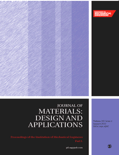
PROCEEDINGS OF THE INSTITUTION OF MECHANICAL ENGINEERS PART L-JOURNAL OF MATERIALS-DESIGN AND APPLICATIONS
Driving Progress in Design and Manufacturing SolutionsPROCEEDINGS OF THE INSTITUTION OF MECHANICAL ENGINEERS PART L-JOURNAL OF MATERIALS-DESIGN AND APPLICATIONS is a prestigious academic journal published by SAGE PUBLICATIONS LTD, focusing on the dynamic fields of mechanical engineering and materials science. With an impressive impact factor reflective of its rigorous scholarly contributions, this journal serves as a vital platform for the dissemination of innovative research and practical applications in materials design and engineering processes. Since its inception in 1999 and continuing through 2024, it has maintained a robust reputation, achieving a Q2 ranking in both Materials Science (miscellaneous) and Mechanical Engineering categories, as well as commendable Scopus ranks that place it in the top percentiles of its fields. Located in the United Kingdom, the journal encourages submissions from researchers and professionals who are seeking to advance their understanding of materials applications while fostering interdisciplinary collaboration. Although it currently operates under traditional access terms, the journal prioritizes impactful research that addresses contemporary challenges in design and manufacturing, ensuring that it remains a must-read for anyone invested in the innovations shaping our technological landscape.